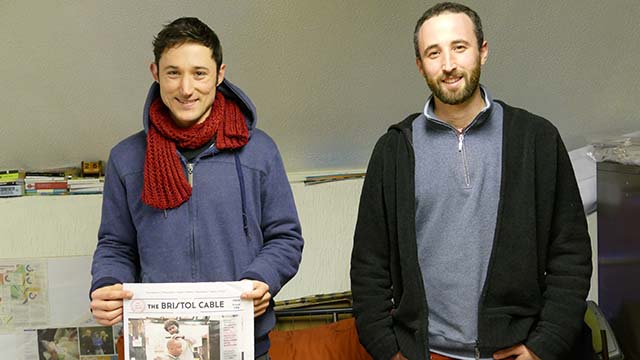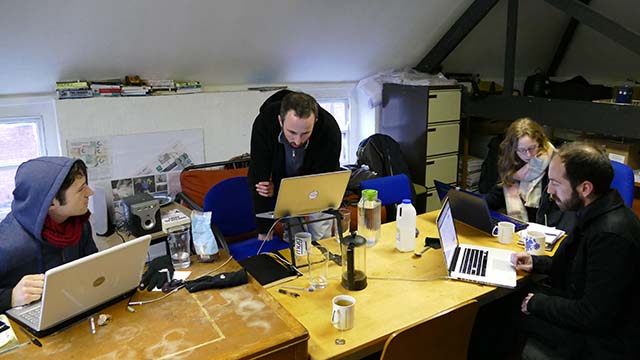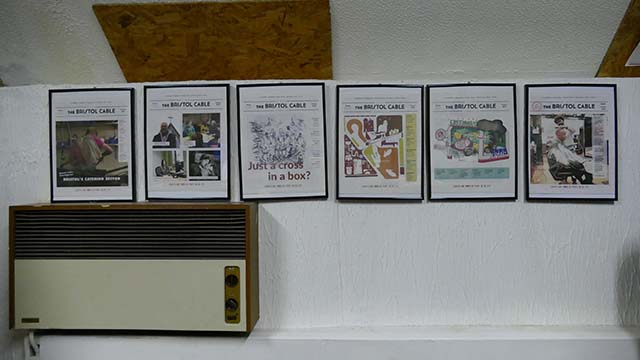InterCardiff meets with Alon Aviram, co-founder of The Bristol Cable as he talks about his journey from part-time caterer to co-founding a community-powered media publication.

Holed up in the attic of a rented building in a more subversive locale of Bristol, a small team of Bristol Cable members are huddled together in infrequent conversation as busy fingers tap away towards a joint goal of the 7th quarterly print issue.
Boasting a membership of 850 Bristol citizens, who jointly own this democratic media co-operative, the Cable has come a long way since its birth in 2014.
Alon Aviram, hovering over shoulders peeking and probing, excuses himself to join me in the borrowed space of the second-floor photo studio, as he settles down hugging a hot cup of tea. Alon, an International Relations graduate from Sussex University, started his career in the catering sector before freelancing for Vice, Channel-4 and an Israeli-Palestinian magazine, +972. Alon explains that it all began with, “A few friends working in different areas, mainly in kind of low-skilled jobs because that was all we could find, who were interested in how we could hold power to account and also have the most impact.”
The conception
“We were looking at the media landscape and realized that a lot of the information that’s produced doesn’t really have an impact. The readerships were narrowly defined and quite inaccessible” explains Alon.
Interested in finding a model that was self-sustainable and which could deliver investigative and high quality journalism, he further adds, “We were intrigued by co-operatives and thought perhaps we could join the idea of a co-operative model with a media organisation.” Rooted in the strong belief that ‘it is essential for every society to have an independent and accountable media source’, the Cable is trying to challenge what people understand by community media publication.
“Community media is often a synonym for amateurs. Whereas, we are 100% responsive to what the community demands, at the same time we also trying to maintain a quality; you don’t usually see that ambition in local media, which is really the problem, making it boring and unengaging and people don’t read it.” Alon describes his clear-cut analysis of the local media organisations.
The time in the womb
For Alon, the community has been an important part of his journey. Back when he started with a two-member team, his first big presentation was at a local community centre.
“We approached hundreds of people from across the city, from unemployed young people to professors to youth clubs and media professionals, and asked them what they thought of the idea, got a lot of interesting feedback which informed the process,” explains Alon. After 3 months of developing the structure, the idea and the concept, which were still very much in its infancy, the Cable raised £3300 through crowdfunding.
Alon who defines the Cable as an ‘investigative educational communicative publication that amplifies local people’s voices is proud to say, “We used two-thirds of that money for just running educational programs across the city, which were free with around 300 participants, we did it on everything from how to use social media for journalists to low-budget filmmaking and the basics of article writing.”
Alon strongly emphasizes the importance of meeting people face to face “We were knocking on people’s doors, it is something that’s overlooked by a lot of organisations these days. And we are finding now, one and a half years later, a lot of the people we talked to on the streets now have a really good relationship with us, whether it’s radio stations or people who are giving us tipoffs.”
Off the back of those workshops, people got involved in creating the first edition. “So people picked up really valuable skills and they were like right on applying those skills in actually creating content.” says Alon.

The birth and growth
On October 2014, Bristol Cable came out with its first issue lead by the investigative story on the exploitation in the catering sector as they attempted quantitative ways of corroborating their personal experiences in the field by developing and researching.
The Cable’s reception varied across different communities. Alon explains there was a level of interest from more established media circles and a lot of cynicism, “But otherwise it was very well-received because it was very different from other ideas, people were not sure what to make of us, how to box us, we weren’t activists we weren’t charity types and we weren’t professional journalists so where do these people fit?”
Over the course of six editions, the members of the Cable have come to love how the Cable intelligently challenges the empowered sector and they want more of the slow journalism and long investigative pieces, with an increasing demand for more multimedia content on their website.
The Cable’s firm foothold in their print sector is somewhat unique, “We are not a newspaper in the sense. Our first edition which was published a year ago still has a lot of stuff in it which is absolutely relevant to today. It has value, so people can hold on to it,” believes Alon.
Also, the Cable has first-hand experience with communities who aren’t digitally active “For instance, in my area there are a lot of internet cafes, clearly suggesting the lack-there-of smartphones and computers among the community. And then there a lot of old people. We take a bunch of our copies to old age homes.” explains Alon.
What’s next?
“We are currently finalizing the budget for the upcoming year which will see around 20 people get paid for their work, which is a really important step in the right direction. It will be really interesting to see an organisation mature form a volunteer led start-up to an organisation that’s really paying people” says Alon
They are putting out a proposal to change the number of times they print, from quarterly to once every two months. Also, “We are trying to step up our capacity to do investigations by linking up with the people of Centre of Investigative Journalism, and ultimately we want to reach 2500 members by spring 2017 which will bring us enough money to run us on a skeleton budget,” explains Alon.

With a seventh framed edition set to go up on the low attic wall by the end of the month, the Cable will soon outgrow their humble abode, and at the rate at which they are growing with a massive new 250 members last month, spring 2017 might arrive earlier than expected.
